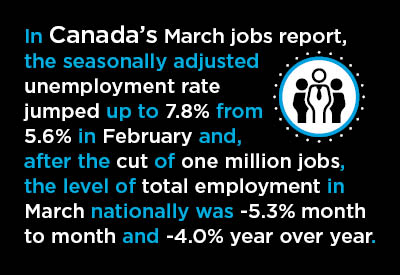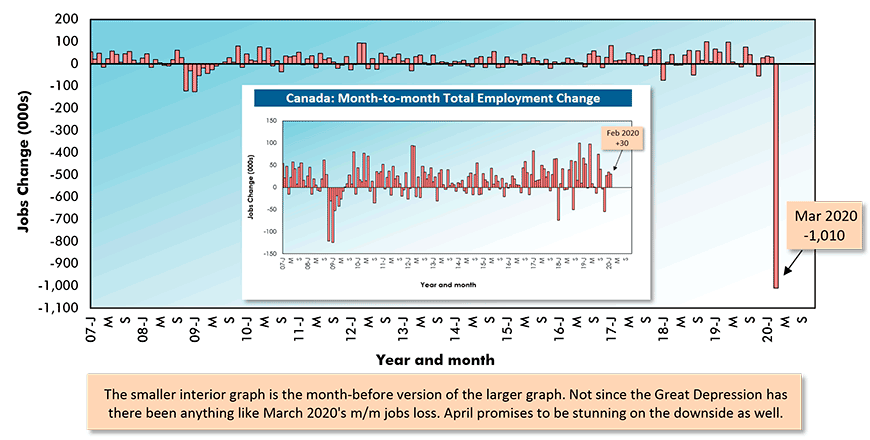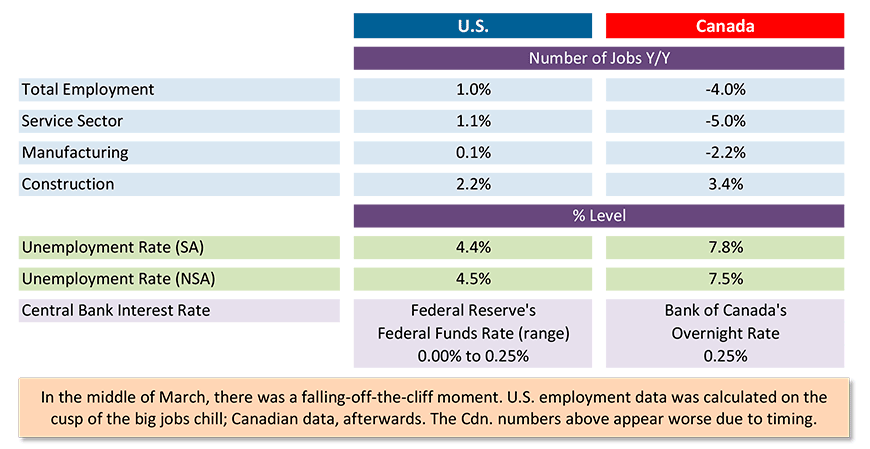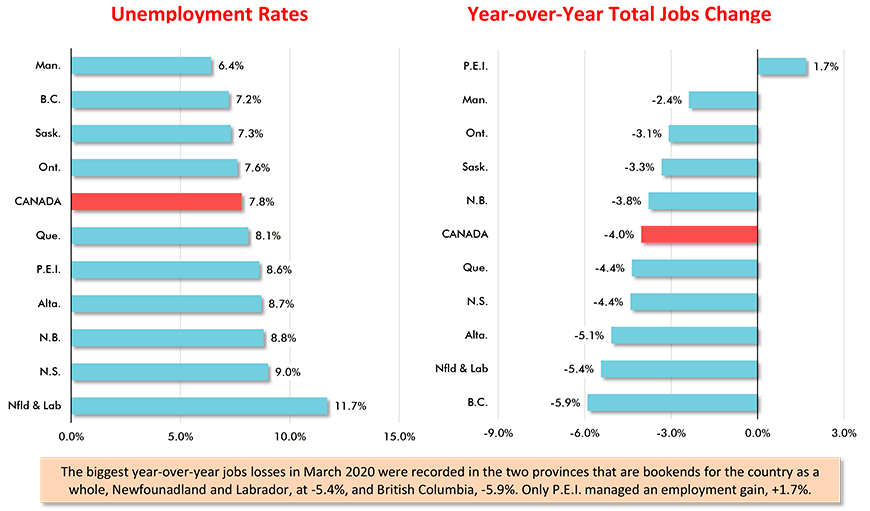March 2020 – The Most Notorious Month for Job Losses Ever (So Far)
The Bureau of Labor Statistics (BLS), in its Employment Situation report, says the U.S. shed 710,000 jobs in March 2020. Statistics Canada, in its Labour Force Survey report, spells out a drop of 1.010 million jobs north of the border in the latest month.

The fact the U.S. jobs figure held up better than the Canadian, in relative terms, has to do with a timing issue.
In most months, the U.S. and Canadian jobs results are published on the same day (and it’s normally a Friday, unless there is a holiday standing in the way).
In March 2020, ‒ the month (so far) in which there was the greatest adjustment in employment in all modern history, ‒ Canadian results were delayed by a week versus the U.S. numbers. (The words ‘so far’ have been inserted in brackets in the foregoing sentence because April’s negative findings, to be published in early May, are likely to be even more extreme.)
There was a falling-off-the-cliff moment in Mid-March. A collective decision was made by government authorities to more firmly assert ‘stay at home’ directives to stem the coronavirus pandemic, which has been overwhelming health care capabilities in many jurisdictions.
A bonfire of lay-offs and furloughs was ignited overnight.
The U.S. jobs numbers for March were derived from employer and household surveys carried out around the 12th of the month. They were calculated on the cusp of the big chill in jobs.
Canada’s figures come from surveying efforts made from the 15th to the 21st of March. Since they’re a snapshot taken a bit later, they capture the immediate swift downsizing initiatives launched by employers.
Graph 1: Canada: Month-to-month Total Employment Change

Chart: ConstructConnect.
Young People Working Part Time in Services Hurt the Most
Some of the most notable findings spelled out in Canada’s March jobs report are as follows.
- The seasonally adjusted unemployment rate jumped up to 7.8% from 5.6% in February;
- After the cut of one million jobs, the level of total employment in March nationally was -5.3% month to month and -4.0% year over year;
- Almost all the job cuts (-964,000) were in the private services-providing sector, -5.0% y/y;
- Employment (-34,000 jobs) in the Canadian manufacturing sector was -2.2% y/y;
- Employment in construction (down only -2,000 jobs) was still buoyant, +3.4% y/y;
- Full-time employment (-474,000 jobs) was -3.0% m/m and -1.5% y/y;
- Part-time employment (-537,000 jobs, but gouged from a smaller base than the full-time component) was -15.0% m/m and -15.5% y/y;
- In a comparison of private versus public sector jobs, the former bore almost all the burden, -866,000 jobs to -144,000 jobs;
- Private sector jobs were -5.7% m/m and -4.7% y/y; public sector jobs were -3.7% m/m and -1.4% y/y;
- In the young worker cohort (i.e., both sexes, aged 15 to 24), employment in March was -15.4% m/m and -13.5% y/y.
- For young people engaged in part-time work, their jobs number in March was -25.8% m/m (i.e., down by one quarter) and -23.2% y/y.
Bottom line: in March, young adults working part-time in the services sector had their employment status undercut severely.
Like in the U.S., jobs in ‘retail’ and ‘accommodation and food services’ were particularly at risk.
And finally, except for in Quebec, construction was still being judged ‘essential’ across the country. Queen’s Park in Ontario has since taken a harder stand.
Graph 2: U.S. and Canadian Jobs Markets – March 2020

U.S. labor data is from a ‘payroll survey’ / Canadian labour data is from a ‘household survey’.
Canadian NSA unemployment rate ‘R3’ is adjusted to U.S. concepts (i.e., it adopts U.S. equivalent methodology).
Table: ConstructConnect.
Quebec Takes Worst Labour Market Hits in March
Moving from February to March, three provinces saw unfortunate deteriorations in their unemployment rates: Quebec, from 4.5% to 8.1%; Ontario, from 5.5% to 7.6%; and British Columbia, from 5.0% to 7.2%.
Manitoba now has the lowest jobless rate in the country, 6.4%. ‘Newfoundland and Labrador’, which is inordinately dependent on seasonal resource industries (e.g., the fisheries sector), has the highest unemployment rate, 11.7%.
As for employment change in March, the most severe declines came in Quebec (-6.0%), Ontario and Nova Scotia (each at -5.3%) and B.C. (-5.2%).
On a year-over-year basis, the provincial jobs-change results were most dramatic in B.C. (-5.9%) and Newfoundland and Labrador (-5.4%), the far-east and far-west bookends of the country.
Graph 3: Canada’s Provincial Labour Markets – March 2020

Chart: ConstructConnect.
Alex Carrick is Chief Economist for ConstructConnect. He has delivered presentations throughout North America on the U.S., Canadian and world construction outlooks. Mr. Carrick has been with the company since 1985. Links to his numerous articles are featured on Twitter @ConstructConnx, which has 50,000 followers.










Recent Comments
comments for this post are closed